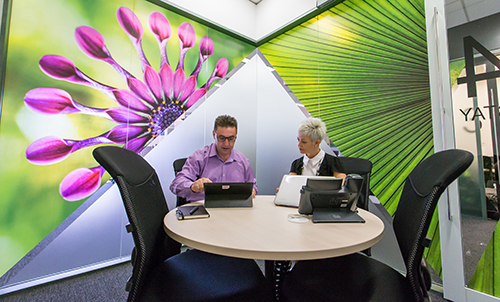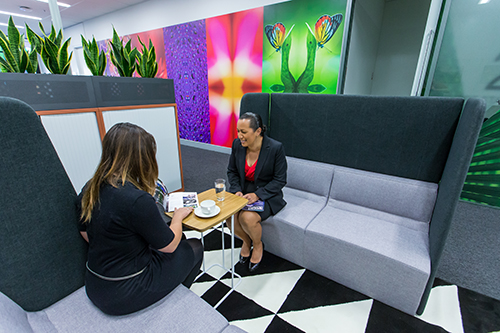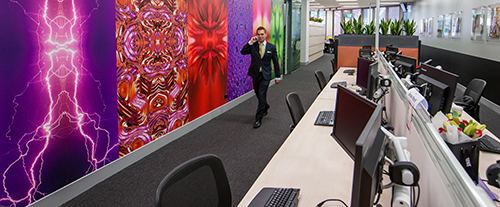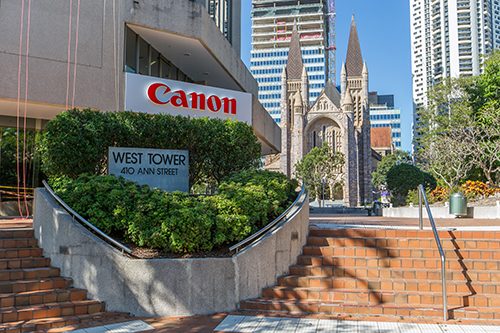Canon shoots for innovation
THE recent concentration of staff and services into new hubs in Brisbane and Sydney is Canon’s innovative shot across the bows of its competitors.
The new city office heralds a new approach in Brisbane, for example, where staff were integral in not only deciding the form and strategic layout of the building, but also providing their own photographic art to decorate the premises – printed on site, of course, on Canon’s large format printers. 
Canon recently released research showing staff must be aligned with the ethos and direction of the company to be successful in this age of disruption. The way Canon is transforming its presence in Australia, starting with its offices to influence work practices and collaboration, is proof that it believes its role as ‘an imaging company’ includes working with staff on the big picture.
Canon Australia and Oceania managing director Yusuke Mizoguchi said the research showed Australian businesses were recognising that the workplace and its people should be at the top of the business agenda – and Canon was making changes to embrace this. The recent opening of a new Brisbane office in Ann St demonstrated Canon’s commitment to collaborating directly with staff to achieve “high performance” working environments that sought out constant innovation, he said.
“We live in a business environment where disruption is the norm and where the necessity for businesses to fully understand, engage and embrace their employees and their customers has never been greater,” Mr Mizoguchi said. “We have started on this journey of change and would welcome the opportunity to pass on the benefit of our learnings – along with the insights from this research – to others.” 
The new Brisbane office makes a statement about what Canon stands for through its spectacular display of large format wall-sized images – all sourced from staff – and then with such innovations as a fully-equipped central kitchen and café-style meeting area, where all staff are encouraged to gather for breaks. There are quiet areas that can be used for staff and client gatherings and there are areas that encourage ‘water-cooler’ style conversations – where ideas can bubble forth.
There are no fixed desk positions, although there are plenty of places for staff to hook up laptops and mobile devices. In fact, staff are asked not to stay in one spot for more than two hours – so they can both get a break and meet someone else from the organisation.
Another reason staff and management gather at the kitchen regularly is that they must deposit their rubbish into various recycling and waste bins. 
“There are no bins at the desks, you see,” Mr Mizoguchi said. “This is both part of our sustainability program and to encourage more collaboration.”
The new offices and the new ways of working are more than an internal change to promote better working environments, they are a lead to the way Canon works collaboratively with staff in this age of digital disruption.
Much of what has happened in Brisbane is an evolution from Canon’s previous adaptation of its Macquarie Park Australian headquarters in Sydney.
Canon communications manager Kylie Church said after 20 years at Macquarie Park, Canon wanted to go beyond “refreshing the place” and incorporate agents of change that would help the company thrive and realise its promise of being the leader in imaging across all industries.
“Canon has used its experience at Mac. Park to extend high performance working … to improve the brand and show how Canon can help clients in new ways,” Ms Church said. “Plus, we have a deep and growing commitment to the Brisbane market.”
Ms Church said the new office was also designed to accommodate Canon’s recent purchase of OCE, while allowing all South East Queensland staff to operate out of one office – before there were two. It is estimated the consolidation saves Canon about $250,000 a year in office costs.
“Number two, we wanted to improve innovation and collaboration,” she said. A third priority was to demonstrate, with the new premises, that Canon is leading imaging company, so staff were invited to “share their ideas visually”.
The way this was achieved was through what Canon calls its ‘change champions’ who helped to deal with staff challenges such as parking and public transport
“Staff don’t just support it, they want to be involved,” Ms Church said.
Canon practised what it preaches to clients – there is very little paper on the premises. Staff get one locker each, but the rest of the material is all scanned in using Canon document management systems.
Success comes down to inclusion and culture and communication,” Ms Church said.
“It was a very collaborative approach and a co-design approach,” Ms Church said.
Canon’s specific research into working styles of its staff revealed there were two basic working categories: ‘focused’ and ‘mobile’. 
“Focused is 79 percent concentration, 10 percent contemplation and 11 percent collaboration,” Ms Church said. “Mobile is 77 percent collaboration, 4 percent contemplation ad 19 percent concentration.
“So they simply fitted the environment to the work style: focused versus mobile.”
It was a good case study for Canon’s own systems and now gives staff confidence to pass on what they have learned to clients. The entire workflow process is supported by Canon MDS and Uniflow and make the most of mobile devices, which can be plugged in to a choice of spaces at the office.
The way the layout now works, the collaborative areas are is next to the active areas, and then there are ‘focused’ spaces set aside.
Mr Mizoguchi said Canon sustainability played out at the Ann Street Brisbane site, which is Five Star Green Star. It has low energy consumption, waste streams are all centralised to manage waste better and there are planter boxes throughout for air quality and visual stimulation.
“We truly belie in high performance working,” Mr Mr Mizoguchi said. “People can perform to their best.”
There are 60 staff in Brisbane and only two are in the focused roles, he said, plus there are 10 sales people who are also mobile. There are four start-up desks
“Canon is measuring the results in Brisbane and Sydney, but the view is that the new office works far better from an efficiency, hygiene, employee well-being and functional perspective,” Mr Mr Mizoguchi said.
Another big advantage was that the single office provided a much broader showcase for Canon products, which range from cameras to printers to document management services to medical imaging systems.
“Product wise, it about the variety that Canon does, such as in laser and inkjet (printers) and cameras … and as you see there are so many big (digital) printers in the range now,” Mr Mizoguchi said. “We are trying to extend more variety – which is not organic business. (The question is) what we have to carry?
“More on the point is that, probably, the organic business is still there – we have to grow – but on top of that we have different needs to grow, maybe, in some other sectors.”
Canon, as a result, is making ground in some surprising sectors.
“Canon Specialised Imaging team, about two years ago, recognised the need for that (broadening),” Ms Church said. “Canon Specialised Imaging looks after things like network video cameras, our Smartboard solutions, projectors, all of these kinds of things, and actually that whole business area was set up for that very reason.
“We knew that technology was going to play such a vital role in connecting people, and that part of the business also looks after things like medical. We do a number of medical devices, such as ophthalmic equipment in your local OPSM store that checks – those sorts of things – radiography is in there.
“As an imaging company it all works on much the same sensors, basically. We have portable radiography equipment that can be used under things such as humidicribs in NiQs (NiQ Health operational systems). In hospitals across the country. You can see that the whole imaging spectrum, right up from your printers, is so much more than that.”
Canon Specialised Imaging was created to integrate technologies and extend knowledge across Canon’s customer base to help improve business performance.
Mr Mizoguchi said, “Certainly Canon Specialised Imaging was created to look at some of those future products, whilst continuing with the others.”
Canon Australia human resources and communications director Effie Fox said, “Craig Manson who is the director of the Canon Business Services area has talked to me a lot about exactly that, where they have customised solutions – not just the hardware but also the software.
“They have software like Uniflow – which is what we use internally – and that they customise solutions depending on issues that certain businesses have got.”
She said Canon’s approach was to enquire about what other business challenges client companies were trying to overcome – then see what expertise and equipment might be applied to assist.
“Often (business leaders) do not want to talk with several vendors,” Mr Mizoguchi said, “Particularly when just the one company can provide such a management service that we are aiming for. Of course, sometimes we cannot unveil everything (about what Canon is doing in terms of its own operations) but most likely in HR power or in communication power, for example, it is accessible.
“Often that our customers can visit, to see some solutions first hand.”
Report by Mike Sullivan
ends

 How to resolve AdBlock issue?
How to resolve AdBlock issue?